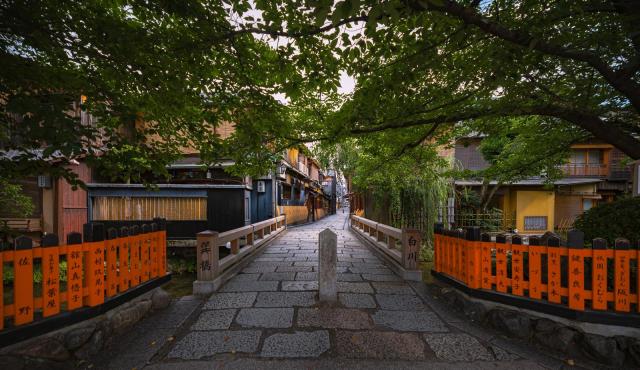Tourist ban now in effect in Kyoto’s Gion geisha district…but are visitors obeying the rules?

A recent video of a maiko being chased by a tourist in Gion proves why the ban is necessary.
Japan is being inundated with foreign tourists right now, receiving more international visitors than ever before in history. Surging numbers of inbound travellers means the country is being forced to readdress its overtourism problem that died down temporarily during the pandemic, and now that visitors have ratcheted up to never-before-seen levels, unprecedented measures are being taken.
One such area where new measures have been put in place is in Kyoto’s famous Gion district, where geisha and maiko (trainee geisha who are usually 16 to 17 years of age) live and work. The ornate costumes worn by these young women make them something of a tourist attraction for foreign tourists, who photograph them as they walk to work along the paved streets. Some tourists have been known to aggressively pursue these women in order to get a perfect photo, leading them to be known as “maiko paparazzi“, and geisha and maiko feel threatened by their incessant behaviour.
▼ After one geisha had part of her clothing torn and another had a cigarette butt inserted into her collar, a photography ban was introduced in October 2019.
京都の人気の観光スポット、祇園で観光客によるマナー違反が深刻になっているとして、地元の協議会は、周辺の私道での写真撮影を原則、禁止にすることを決めました。https://t.co/Bga3PwZPDu#nhk_news pic.twitter.com/RuOPnGO0v6
— NHKニュース (@nhk_news) October 25, 2019
Five years after the photography ban was introduced on “私道” (“shidou”), or “private roads” in the area, the local council announced it would be taking things even further by banning tourist access to some of these roads altogether. The decision wasn’t made lightly, as locals had chosen to kindly overlook the fact that visitors were essentially trespassing on private property for years, but with tourist numbers increasing, it has become harder for businesses, residents, and tourists to coexist harmoniously in such confined spaces, so action had to be taken.
In April, the local council announced it would start restricting access at one of the area’s most famous private roads, Kosode Koji, with the proposed no-entry sign seen at the cued-up point in this report below.
The message on the sign read, “This is a private road, so you are not allowed to drive through it. There will be a fine ¥10000” in English, although the Japanese translates as: “Private Road Beyond This Point. Passage Prohibited.”
However, on 29 May, the no-entry sign was installed at the entrances to Kosode Koji and it had a new design, written in English, Japanese and Chinese, with the English reading: “Private Road Do Not Enter Fine up to ¥10,000“. The message in Japanese is a lot more detailed, translating as: “Due to this being a private road, photography and entry by tourists and guided tours is prohibited.”
▼ The new sign can be seen at the beginning of this report below.
Despite the different nuances, the message is clear — if you don’t live or work on the road, then do not enter. According to Gion Southside District Council Director Isoichi Ota, this is the first of a number of signs they plan to erect at private roads in the area, in order to help protect the lives of locals.
▼ Gion’s private roads are marked in red at this point in the video below.
Not long after the signs went up, Japanese media outlets were quick to scope out the scene, watching to see how tourists would react. Would they break the rules and enter? Or respect the sign and walk on by?
▼ The cued-up spot in the below report shows that tourists surprised the local media outlets by…obeying the rules.
According to the report, nobody was seen entering the road, and when they spoke to tourists, they were understanding of the issue.
▼ Tourists react to the new road restrictions.
It’s heartening to hear tourists respecting the locals’ wish for privacy, so the sign is already proving to be effective. The more locals see tourists being respectful of private roads, the more chance there is that the road restrictions won’t spread even further, making life in Gion better for everyone.
▼ So remember, don’t act like the tourist seen at the start of this video, who recently went viral for being a “maiko paparazzi”.
It’s easy to get caught up in the beauty of Japan, especially in a place with so much history like Gion, and though the locals are prepared to put up with a lot of interruption to their daily lives, sometimes it gets to a point where action has to be taken.
With the town of Fujikawaguchiko recently erecting a blackout screen to block a view of the so-called “Mt Fuji Lawson” that had become popular on social media, local governments are proving they aren’t afraid to put their foot down when it comes to overtourism. Here’s hoping more stringent measures don’t have to be put in place, especially at sites in Kyoto, because the city has a history of severing ties in dramatic fashion.
Sources: Asahi, FNN
Featured image: Pakutaso
● Want to hear about SoraNews24’s latest articles as soon as they’re published? Follow us on Facebook and Twitter!
Credit:

0 comments:
Post a Comment